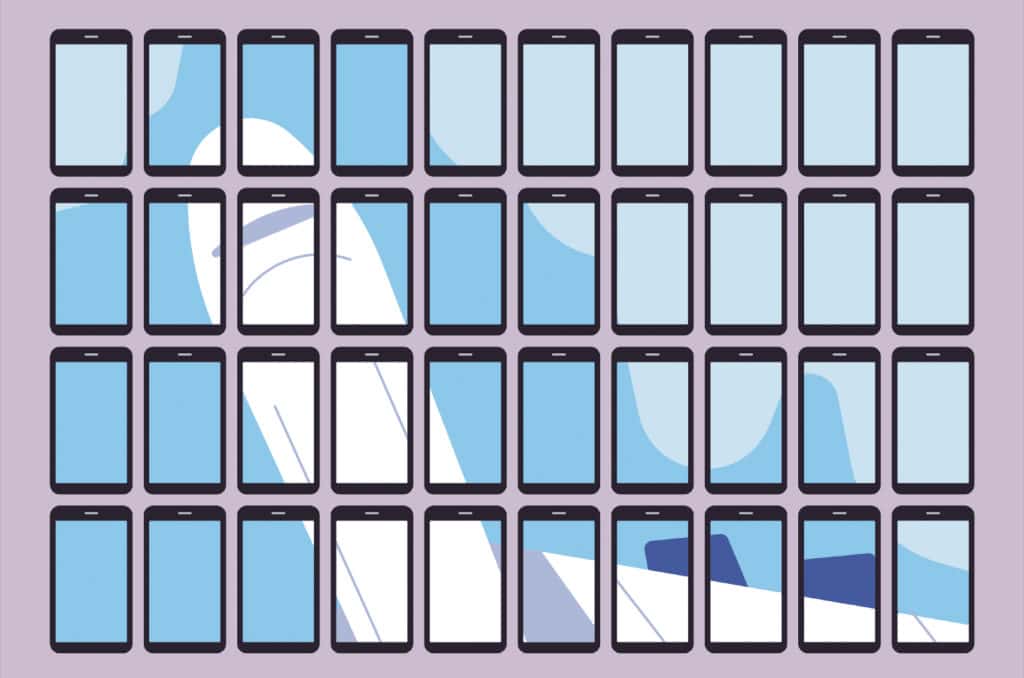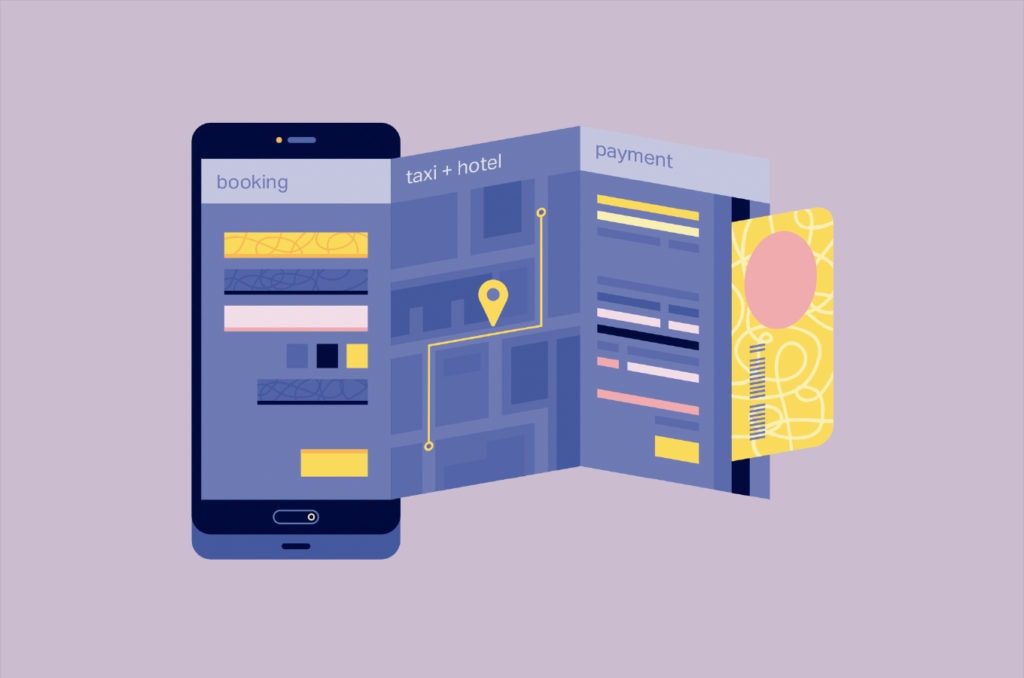
APEX Insight: The right product for the right customer at the right time and on the right device. In the experience era, knowing your customers’ needs has never been more important.
We live on our smartphones, faces fixed upon the blue glow of the screen as we move zombie-like through the world. Really, though, our mobile interactions are how we seek to augment our daily experiences to better suit our ever-changing needs and wants. While we’ve always dreamed, planned and made choices as we’ve traveled, now we can actually act on them in real time. It is during these micro-moments – these inflection points of curiosity and decision – when customers turn to their electronic devices for help, be it to learn, to remember, to assess or to buy.
More than 200 customer touchpoints were identified over the course of a hypothetical weeklong ski trip from Paris to Aspen, from inspiration to travel to coming back home.
More and more customers are using their mobile devices to make travel purchase decisions every year, according to a study by Google – and they’re making these decisions faster. From the time the traveler imagines her getaway to the points at which she hunts for a ticket, books accommodation and navigates a foreign airport in search of a taxi and cup of coffee, micro-moments of engagement pop up for airlines and airline-adjacent services to step in, thanks to location and data analysis technologies that are still relatively new.
Hungry for New Sales Opportunities
Airlines have proven themselves masters of revenue capture, but there’s a ceiling for seat selection and upgrade fees: Future growth lies in ancillary revenue. Indeed, a recent Amadeus-Accenture report finds that some airlines make 40 percent of per-passenger revenue from ancillary sales. Passengers – human beings that they are – love choices, so airlines must efficiently surface the ticketing and ancillary-sales alternatives available. “I’ll take the chocolate cake for five euros if it is the only choice I have,” Valerie Viale, head of Dynamic Pricing and Revenue Optimization at Amadeus, says. “But if I have the choice between a chocolate cake at four euros and a cheesecake at eight euros, I’ll have the cheesecake – I do love cheesecake!”

Mike Slone, chief experience officer of Travelaer, a startup that builds Internet booking engines (IBEs) and conversational customer-engagement platforms, identified more than 200 customer touchpoints over the course of a hypothetical weeklong ski trip from Paris to Aspen, from inspiration to travel to coming back home. He and his team also found that over one-quarter of those customer touchpoints were found via Facebook entities – be it the main platform, Facebook Messenger or Instagram. Facebook’s privacy scandal notwithstanding, this is a highly significant data point for companies that are considering their digital strategies.
Find Your Way There
One clear micro-moment is in the booking phase: When someone books a flight, the opportunity presents itself to offer a hotel or rental car deal. Messaging is key here, both visually and in writing. Travelaer worked with Finnair to revamp the airline’s booking engine, empowering it to include hotel bookings and ancillary sales. “We started working with Finnair in 2016 and built upon all of our experiences working with stopovers and Icelandair for almost six years,” Slone says.
Travelaer learned how important the visual aspects of the process were to the traveler, and developed accordingly: “We combined a mapping element that is connected to the booking widget to display the customer’s itinerary and timeline on the map, so that customers could visualize what they were booking before they ever leave the booking widget.”
“Maps and augmented reality are the perfect canvas to surface contextualized information; they allow passengers to explore where they want to spend their time.” – Campbell Kennedy, LocusLabs
The term “customer journey” has reached buzzword status in the online retail community, but travelers are on a physical journey, too, opening up the opportunity for offline touchpoints. Advances in indoor mapping technology have provided new opportunities for reaching travelers in a rush: Five minutes is enough time for that cup of coffee from the café you didn’t even know was there. “In today’s world, where consumer experience is king – the experience era – it’s imperative to offer a great experience to increase customer loyalty, which inevitably leads to increased sales,” says Campbell Kennedy, CEO and co-founder of LocusLabs, an indoor wayfinding startup. “We also know that when passengers are less stressed, they spend more money, according to a recent SITA study.”

Like Travelaer, LocusLabs works closely with mapping technology, albeit at a different scale: “Since maps and augmented reality are the perfect canvas to surface contextualized information, offers or vouchers, they allow passengers to explore their options to see where they want to spend their time,” Kennedy says. “And often, time is money.”
Kennedy cites security queues as a squandered opportunity for airports to further engage their customers, adding that it would pay off if travelers knew exactly how far they were from their gate, which would in turn mean knowing how much time they have for shopping or a second drink at the bar. “The entire in-airport portion of the journey is largely missed,” he says. “Today’s airports have mostly physical signage and storefronts with almost nothing in the way of digital. However, look at all the people staring down at their phones next time you’re at an airport!”
Dynamic Pricing: Risk and Reward
Dynamic pricing is another method for reaching travelers at a critical point in their journey. The selection of a coach-class fare has long been a potential micro-moment, but is only now being actualized as airlines leverage data on how previous passengers behaved at that point in the sales funnel over time. Those insights can pay off, using pricing fluidity to sell a seat not only at different price points depending on demand, but also to meet different sets of expectations. Among the airlines experimenting with bare-bones basic economy fares, and for-purchase add-ons, is American Airlines, which prohibits basic economy passengers from using the overhead bins. What was once a seat with presumed space for a passenger’s personal effects has become something different: space as a service, if you will, with upsell opportunities both at the time of booking and as a last-minute upgrade should someone end up packing more carry-on luggage than anticipated.
“If any investment is going into IBEs, it is allowing airlines to sell complementary products better, such as ancillaries.” – Mike Slone, Travelaer
This fare structure enables traditional airlines to compete with low-cost carriers and ultra low-cost carriers (ULCC), at least at first blush. However, it forces passengers to pick their poison: pay extra to use the overhead bin or pay extra to check a bag – unless the carry-on is tiny enough to share precious under-seat space with their feet.
This is where airlines must be wary of fare dilution: If every airline, from ULCC to legacy, begins offering services that are seen as too similar – or if an add-on fee is seen as unavoidable in any case – the passenger will simply opt for the less expensive option. Slone warns that such granular fare-class differentiation is customer-unfriendly, as the benefits and limitations of each are difficult to parse by customers navigating the buying process on their phones. “If any investment is going into IBEs, it is allowing airlines to sell complementary products better, such as ancillaries,” he says.
Air-Travel Ecosystems

Icelandair has long embraced a holistic approach to sales, incorporating its hotels into its multiday stopover program since the 1960s. Ryanair has incentivized customers to stay in its travel ecosystem with Ryanair Travel Credit, rewarding those who stay at Ryanair Rooms with a 10 percent flight discount. Meanwhile, Air New Zealand (ANZ) is recognizing its own in-flight Wi-Fi service as a potential platform for sales partnerships outside the cabin, with an eye toward offering the traveler the right product – whatever it may be – at the right time and place. To that end, ANZ is experimenting with a customer-communication chatbot to better scale a passenger-by-passenger understanding of purchasing preferences.
These endeavors require knowledge of passenger desire at a given micro-moment: “The concept of dynamic pricing is to optimize the price of the product, in real time, with the best knowledge of which customer segment is asking and what their purchase behavior is, as well as what other providers are offering at that time,” Amadeus’ Viale says. That’s a lot of moving parts.
“The concept of dynamic pricing is to optimize the price of the product, in real time.” – Valerie Viale, Amadeus
With such an ambitious goal, airlines and travel service providers need to fine-tune their tools. “Take responsive user interfaces and mobile applications,” Slone says. “OTAs [online travel agents] and metasearch sites like Expedia and Skyscanner have had a responsive user interface for years, whereas most airlines today still don’t have responsive user interfaces, much less iOS and Android applications.” Airlines would do well to adopt that fail-fast startup mentality, he says, to keep up with customer expectations and unlock engagement potential.
Getting to Know You
Identifying micro-moments is a heuristic process – bit by bit, larger and more complete pictures of traveler behaviors emerge from a million unique journeys. “At the inspirational phase, the shopper will not have shared the length of stay, or if there is a Saturday night at the destination,” Viale says. “When we have that information, we can reasonably assume a leisure type of travel (and a higher price sensitivity). At the inspirational phase, the vision of the passenger and [that passenger’s] shopping behavior is likely to be more unclear.”
One thing is clear, though: It pays to be there when the customer needs you, with the right message at the right time – as if you’re both thinking the same thing. As Kennedy says, “Modern mobile users are very fickle and know a good experience when they feel it.” So, make sure your passengers know about the cheesecake.
“Living in the Micro-Moment” was originally published in the 8.3 June/July issue of APEX Experience magazine.


